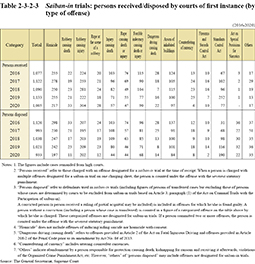3 Saiban-in trials
In Saiban-in trials, a panel consisting of three professional judges and six saiban-ins (lay judges chosen from the public for each case) (one professional judge and four saiban-ins, in exceptional cases) conducts deliberations to make a determination on fact finding, applications of laws and regulations and sentencing. In the deliberations, determinations are made by a majority opinion of the panel which must include opinions of both professional judge(s) and saiban-ins.
District courts handle the following cases through saiban-in trials: [1] cases involving offences punishable with the death penalty or life imprisonment, and [2] those involving crimes, subject to imprisonment for a minimum period of not less than one year, which caused a victim's death by intentional criminal acts. When a district court determines in consideration of behavior of a defendant, etc. that, [1] there is possibility that lives, bodies or property of saiban-ins, their family members or similar persons could be harmed, and [2] the possibility makes saiban-ins, etc. feel so threatened that it is difficult for saiban-ins to perform their duties, then, the court must render a ruling that such case is to be handled by a panel consisting of professional judges only. In 2020, the number of defendants whose cases were handled by a panel consisting of professional judges only was two (Source: the General Secretariat, Supreme Court).
Table 2-3-2-3 shows the number of persons received or disposed by courts of first instance (including case transfers, etc.) by means of saiban-in trials by type of offense.
Table 2-3-2-3 Saiban-in trials: persons received/disposed by courts of first instance (by type of offense)
